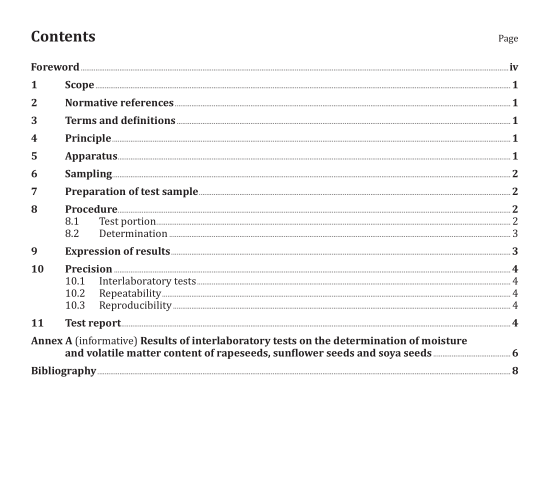EN ISO 665:2020 pdf download.Oilseeds – Determination of moisture and volatile matter content (ISO 665:2020)
4 Principle
The moisture and volatile matter content of a test portion is determined, either on the material as received (pure seed and impurities) or, if required, on the pure seed alone, by drying at 103 °C ± 2 °C in an oven at atmospheric pressure, until practically constant mass is reached.
5 Apparatus
Usual laboratory apparatus and, in particular, the following.
5.1 Analytical balance, capable of weighing to the nearest 0,001 g.
5.2 Mechanical mill, easy to clean, suitable for the kind of seed and allowing the latter to be ground without heating and without appreciable change in moisture, volatile matter and oil content.
5.3 Mechanical grater or, if not available, a hand-operated grater.
5.4 Flat-bottomed vessel, either of metal or glass, at the discretion of the analyst. If metal is used, it shall be resistant to attack under the test conditions. The vessel shall be provided with a well-fitting lid and shall allow the test portion to be spread to about 0,2 g/cm 2 (e.g. a vessel of diameter 70 mm and height 30 mm to 40 mm). Glass vessels with ground closures may also be used.
5.5 Electric oven, with thermostatic control and good natural ventilation, capable of being regulated so that the temperature of the air and of the shelves in the neighbourhood of the test portions lies between 101 °C and 105 °C in normal operation. 5.6 Desiccator, containing an efficient desiccant such as phosphorus(V) oxide, silica gel, activated alumina, etc., and provided with a ceramic plate that allows vessels (5.4) to cool rapidly. 6 Sampling Sampling is not part of the method specified in this document. A recommended sampling method is given in ISO 21294 [1] . It is important that the laboratory receive a sample that is truly representative and has not been damaged or changed during transport and storage.
7 Preparation of test sample
7.1 Prepare the test sample by reducing the laboratory sample in accordance with ISO 664. If large non-oleaginous foreign bodies have been separated before the reduction of the laboratory sample, make allowance for this in the calculation (see 9.2).
According to the requirements of the contract, take a sample as received or after separation of the impurities.
7.2 In the case of copra, grate the product by hand or, preferably, use a mechanical grater (5.3) that allows the whole sample to be treated. When grating by hand, which does not allow all the analysis sample to be grated, endeavour to obtain a test sample that is as representative as possible and, to this end, take account of the size and colour of different fragments. The length of the particles after grating may exceed 2 mm but shall not be greater than 5 mm. Mix the particles carefully and carry out the determination without delay.
7.3 In the case of seeds of medium size (groundnut, etc.), except for safflower seed, sunflower seed, soya beans and cottonseed with adherent linters, grind the test sample in the mechanical mill (5.2), which has previously been well cleaned, until the major dimension of the particles obtained is not greater than 2 mm. Reject the first particles (about one-twentieth of the sample). Collect the rest, mix carefully and carry out the determination without delay.
7.4 Small seeds (linseed, colza, hemp, etc.), as well as safflower seed, sunflower seed, soya beans and cottonseed with adherent linters, are analysed without previous grinding.
8 Procedure
8.1 Test portion
8.1.1 Dry the vessel with its lid for 1 h at 103 °C prior to being placed in the desiccator before weighing. Weigh the vessel (see 5.4) with its lid to the nearest 0,001 g, after leaving it open for at least 30 min in the desiccator (see 5.6) at laboratory temperature.
8.1.2 Then weigh into the vessel, to the nearest 0,001 g, either:
— 5 g ± 0,5 g of the grated product (see 7.2) in the case of copra, meal (see 7.3) or medium-sized seeds other than safflower seed, sunflower seed, soya beans or cottonseed with adherent linters; or
— 5 g to 10 g of whole seed in the case of safflower seed, sunflower seed, soya beans, cottonseed with adherent linters and small seeds.EN ISO 665 pdf download.EN ISO 665 pdf download
